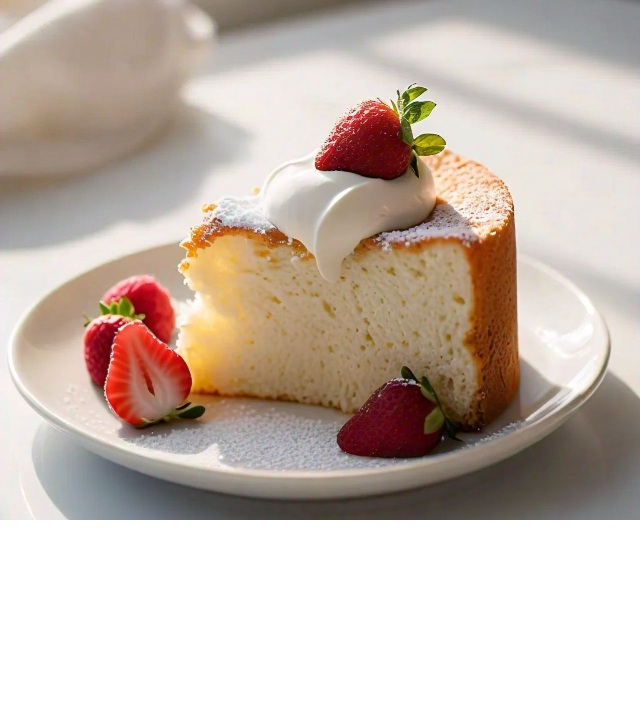what is Angel food cake nutrition
Angel food cake nutrition is a classic dessert celebrated for its light, fluffy texture and delicate sweetness. It’s often seen as a healthier alternative to traditional cakes, making it a popular choice for celebrations and everyday indulgence. This article explores the nutritional profile of angel food cake, its health benefits, potential drawbacks, and suggestions for healthier adaptations.
What Is Angel Food Cake?
Angel food cake nutrition is made primarily from egg whites, sugar, and cake flour, resulting in a light, airy structure. Unlike many other cakes that use butter or oil, angel food cake is fat-free, which contributes to its unique texture and lower calorie count. The cake is typically baked in a tube pan to allow for even rising and cooling.
Angel Food Cake Nutrition Profile
Angel food cake nutrition is A typical serving of angel food cake (approximately 1/12 of a standard cake) offers the following nutritional values:
- Calories: 70-100
- Protein: 2-3 grams
- Total Fat: 0.5-1 gram
- Carbohydrates: 15-20 grams
- Sugars: 10-15 grams
- Fiber: 0-1 gram
Breakdown of Nutrients
- Calories: Angel food cake is relatively low in calories compared to other desserts. This makes it an attractive option for those looking to enjoy a sweet treat without a hefty calorie count.
- Protein: The primary source of protein in angel food cake comes from egg whites. While not a high-protein dessert, it does provide a small amount, which is beneficial for those looking to incorporate some protein into their sweets.
- Fat: The low fat content is one of the cake’s defining features. Since it contains no egg yolks, butter, or oil, it is virtually fat-free, making it a suitable choice for low-fat diets.
- Carbohydrates and Sugars: The cake is rich in carbohydrates, primarily from sugar and flour. While it satisfies sweet cravings, those monitoring their sugar intake should consume it in moderation.
- Vitamins and Minerals: Angel food cake is not a significant source of vitamins or minerals. However, it can be enjoyed as an occasional treat when balanced with nutrient-dense foods.
Health Benefits of Angel Food Cake
- Low in Calories: For dessert lovers, angel food cake offers a guilt-free option that satisfies cravings without excessive calorie intake. This makes it ideal for weight management or for those seeking to indulge mindfully.
- Fat-Free: With virtually no fat, it aligns well with low-fat diets. It provides a way to enjoy cake without the heaviness that often comes with butter-based desserts.
- Versatile Pairing: Angel food cake pairs well with a variety of toppings, such as fresh fruit, yogurt, or whipped cream, allowing for a nutritious boost. Fresh fruits add vitamins, minerals, and fiber, enhancing the overall healthfulness of the dessert.
- Suitable for Special Dietary Needs: Because angel food cake can be made gluten-free with alternative flours, it can accommodate those with gluten sensitivities, provided the ingredients are carefully chosen.
Potential Drawbacks
- High Sugar Content: The cake’s sweetness comes from a significant amount of sugar. For individuals monitoring their sugar intake—such as those with diabetes—this can be a concern. It’s essential to enjoy angel food cake in moderation.
- Limited Nutritional Value: While the cake is low in calories and fat, it lacks substantial nutrients. Relying on it as a primary dessert option may not provide the necessary vitamins and minerals.
- Caloric Add-ons: Toppings and fillings can quickly elevate the calorie count. For instance, adding sugary sauces or heavy whipped cream can negate the cake’s low-calorie benefit.
Healthier Adaptations
If you’re looking to enjoy angel food cake while enhancing its nutritional profile, consider the following tips:
- Use Natural Sweeteners: Substitute some of the sugar with natural sweeteners like honey or maple syrup. This can reduce the overall sugar load while adding unique flavors.
- Incorporate Whole Grains: Using whole wheat flour instead of white flour can increase fiber content, offering additional health benefits.
- Top with Fresh Fruit: Serve the cake with a variety of fresh fruits like berries, peaches, or citrus. Not only do these toppings enhance the flavor, but they also add vitamins, minerals, and fiber.
- Experiment with Flavors: Add extracts such as almond or vanilla to the batter for enhanced flavor without added calories. Incorporating citrus zest can also elevate the taste profile.
- Serve with Yogurt: Instead of whipped cream, top the cake with a dollop of Greek yogurt for added protein and probiotics.
Conclusion
Angel food cake is a delightful dessert option that balances indulgence with a relatively low-calorie and fat-free profile. While it lacks significant nutritional value, it can be enjoyed as part of a balanced diet, especially when paired with nutritious toppings and served in moderation. Whether you’re celebrating a special occasion or simply treating yourself, angel food cake can provide a satisfying sweet experience without derailing your health goals. With a few healthy adaptations, it can easily become a staple in your dessert repertoire. Enjoy this airy cake as a delightful way to satisfy your sweet tooth while keeping nutrition in mind!
please visit our blog for more interesting blogs Ancient Grain Cereal: A Nutritious Powerhouse



